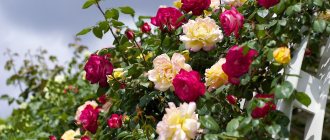Miniature border roses: their photos and descriptions
We offer a brief description of miniature border roses as a botanical crop that has every right to take its rightful place in the garden.
Border roses are distinguished by their small size, which are planted in the same small bushes around the selected lawn.
They differ from the usual roses in their double petals with a complex cut and unusual shape - all this provides the garden with a unique appearance for a long time (subject to high-quality and proper care). They easily survive harsh winters, since due to their short growth they are completely covered with snow for this period and are protected.
Those who like to plant roses at home - don’t worry, you can also plant this variety at home, in an ordinary pot (but it’s better if it’s large). Border roses bloom repeatedly, and some can grow without interruption - until the onset of the first frost.
The border rose can be replaced with a fairly common analogue - a disposable rose. Three or four cuttings are planted in a pot and the result is a compact bush, which is ultimately sold. After they have bloomed, they are immediately thrown away.
But some of the gardeners who feel sorry for throwing away miniature roses plant it again, but in fresh soil in their garden. And they continue to delight the eye with their bright and colorful flowers.
They can be planted in the first row next to taller bushes, or placed on a hill - a rock garden, in particular. If you plant them on a flat or slightly elevated surface, they will grow much easier - the sun and moisture will flow evenly over the entire area of the plant.
Look at the photo of border roses in all their splendor:
Care
Planting and caring for these amazingly beautiful flowers does not cause much trouble, you just need to be an attentive owner, then border roses will delight you with long-lasting flowering. They love warmth, but not heat, they can easily tolerate cold snaps, and if the air warms up above +25 degrees, the bush will be too hot, the roots may overheat, so in extreme heat it is better to mulch the ground around the bushes and shade the above-ground part.
Watering
Water roses often, but not too much; this should be done regularly, preferably in the evening, using settled water heated by the sun at room temperature.
It is very important that the water does not stagnate, otherwise root rot may occur. It is advisable to water the ground under the bush, and not the bush itself; these roses do not like water getting on the greens
Top dressing
Lush color almost all summer requires a lot of effort, so the rose needs feeding
They are carried out several times, but only until mid-summer, otherwise the plant will not prepare for winter, this is especially important where winter is harsh and comes early. Humus or manure is mixed with the top layer of soil and spread evenly under the bushes in the spring.
Under no circumstances should you use fresh manure; it can burn the roots of even an adult plant.
When the first buds begin to form, you can water the bushes with calcium nitrate, 1 tablespoon of which is dissolved in a bucket of water. You can water with this fertilizer only after a good watering, and after that, water again with at least a little water.
Roses respond well to watering with herbal brew or mullein infusion solution. Such fertilizing can be carried out after 2 - 3 weeks. In the first year of life, roses are fed only in the spring, and in the fall compost or peat is used for insulation; for the first year this is enough for them. The hotter the summer, the less fertilizing needs to be done, but in cool, rainy summers you can alternately water it every 2 weeks with a solution of organic and mineral fertilizers.
Because very hot or very rainy weather causes roses to experience stress, they can be very vulnerable. You can help them survive unpleasant weather by using special preparations: Zircon, Epin, Ecosil. You can fertilize miniature roses with products for flowering plants, which are sold in stores - this is much easier to do than preparing solutions and infusions yourself.
Trimming
Sanitary and formative pruning is carried out all summer; if you do it carefully, using a clean, sharp pruner, the roses will tolerate it well, the main thing is to cut it and not flatten the stem. In the first year, all shoots are pinched above the 5th - 6th leaf; this will make the bush lush; it is also advisable to cut off the buds. In adult bushes, the side shoots continue to be pinched or simply shortened, while the central ones usually grow straight up.
You need to cut off damaged shoots and wilted flowers, this stimulates the formation of new branches and flowers. It is imperative to remove wild shoots, which often form on grafted plants; they differ in the number of leaf parts - a varietal rose has a leaf consisting of five parts, and a rose hip has seven parts. Such wild shoots cannot be shortened, because they will grow and multiply, they must be ruthlessly cut out at the level of the root collar, for this you will have to lightly dig up the ground near the root.
In the fall, long shoots are usually shortened, buds that have not had time to bloom are cut off, and then the plant is prepared for wintering. As soon as the first night frosts appear, the fallen leaves are removed, the shoots are trimmed one last time, the bushes are hilled up, raking at least 20 cm of soil.
The main thing is that the roses do not freeze.
Growing and caring for border roses
Caring for border roses is easy. Following a few rules will allow you to admire their lush blooms throughout the entire summer season.
Watering
Water the bushes regularly as the soil dries with settled water and preferably in the evening. Water should be poured under the roots, without touching the above-ground part of the bush.
Top dressing
Fertilizers are produced especially for Rosaceae, which take into account all their needs. For organic matter, you can use well-aged horse manure. Otherwise, the roots may suffer from burns.
Important! When buds appear, phosphorus-potassium fertilizer is applied for lush and long-lasting flowering. In spring and autumn, compost is laid out under the bushes
In addition to feeding, it protects the roots from frost in winter, and from drying out in summer.
In spring and autumn, compost is laid out under the bushes. In addition to feeding, it protects the roots from frost in winter, and from drying out in summer.
Trimming
Proper pruning helps to form a beautiful and healthy bush. Damaged shoots are removed throughout the season.
Cut with sharp pruning shears, retreating 5-7 mm from a healthy kidney
In the first year of life, all shoots of a border rose bush are pinched at the level of 4-5 leaves. In the future, only the side shoots are pruned.
Wild shoots must be cut off from grafted roses. Remove it from the root collar itself; pruning above ground level will not give the desired result.
Features of wintering
Border roses tolerate frost well, but in order not to risk it, it is recommended to insulate them. The plant is covered with earth or compost and the shoots are tied in a bunch on top and covered with spruce branches or dry leaves.
In winter, the bushes will be comfortable under the spruce branches
Reviews and opinions of gardeners
In Russia, the most popular varieties are Lydia, Ruby Star, Mimi Eden, Fire Flash . Reviews about them are left on forums more actively than about others. Moreover, these opinions are mostly positive - these varieties deserve them.
The most frequently discussed issue is wintering. In central Russia, it is advisable to cover the crop for the winter, despite the fairly high winter hardiness of all varietal species. It is recommended to cover with spruce branches or pine needles.
In general, no additional measures to care for the plant are required. The exception is pruning. It stimulates flowering, which lasts throughout the season. When pruning after flowering, leave about 15 cm from the soil surface.
It is advisable to purchase grafted bushes from trusted stores and nurseries, and plant them in the fall, around mid-September.
Trimming methods
Pruning is carried out in three ways. They depend on the length of the stem, the branching of the bush and the type:
- Short pruning is used for polyanthus and small-flowered species. During this pruning, 2-3 buds are left. It is rarely carried out, because there is a risk of the bush freezing.
- Medium pruning is most often used. The bushes are pruned to 35 cm from ground level, 5-7 buds remain on the branch. It is used for all types of roses, with the exception of climbing and ground cover roses.
- Long pruning is suitable when the buds are located on the top of the shoot. Roses are pruned a little or not at all. This pruning is suitable for large-flowered varieties. Types of pruning
Choose medium pruning if you have not decided on the type of rose.
Be sure to remove:
- Old shoots (over 3 years old),
- The shoots are white, young branches (they will not tolerate frost and will become a site for the development of the disease),
- Shoots growing inward.
- Dried buds, flowers, leaves.
Where can I buy?
You can purchase seedlings of these amazing crops in nurseries, gardening stores, buy spray rose seedlings by mail or through an online store.
| Variety | Where can I buy | Price |
| Lovely Lydia | Vyatka roses (Nursery, online store) | 320 rubles |
| Pink flash | Rose growing farm "Kuban rose" | 200 rubles |
| Sasha | LLC "Wonderful Garden" | 350 rubles |
| Midget | Online store "Samara seeds" | 250 rubles |
| Rumba | Vyatka roses (Nursery, online store) | 320 rubles |
Good plant catalogs can be viewed on the website of the Omsk nursery “Wonderful Garden”, on the website “Rose Bushes” of the Krasnodar Territory; also in the Altai selection catalogs there are spray roses of various colors (pink, red, yellow, white and others).
How do border roses propagate?
Miniature beauties reproduce in 3 ways:
- cuttings;
- dividing the bush (seedlings);
- seeds.
Propagation by cuttings
It is considered the easiest way. From May to July, you can cut off semi-lignified shoots and divide them into parts so that 2-3 buds remain on each of them. All leaves on them are shortened by half.
Each shoot is planted only after 3-4 hours of keeping them in the root-forming solution. The distance between them when planting is 30-35 cm. Then each shoot is watered abundantly and covered with a container (glass jar, large plastic bottle). They stay in such a “greenhouse” for about a month and a half. All this time it is necessary to water them regularly. When the shoots take root, they can be dug up and transplanted to a new place in the garden.
Propagation by seedlings
This method is applicable in the fall or spring before the buds open. Dividing an adult bush is very simple. It is dug up and carefully cut into pieces. The main thing to consider is that each part must have a shoot and roots. Then all the resulting shoots are planted in the garden.
Propagation by seeds
Flower growers very rarely resort to propagating border roses by seeds, since this is a long and troublesome process.
All collected (purchased) seeds are germinated for 2 weeks at a temperature of +20 °C before planting. They can be sown in a container with fertile, light soil in late autumn. Seeds are planted 0.5 cm deep
All winter it is important to maintain their temperature from +3 to +5 °C. At the end of spring or in the first days of summer, the seeds will begin to sprout
When buying seeds, the main thing is not to make mistakes
You need to pay attention to the following factors
Best before date. Expired seeds may not germinate completely or may not germinate at all. Color of the purchased variety. The selected miniature roses should be combined with plants already growing in the garden and match them in color. Duration of flowering. It is different for all varieties: some have early, others late flowering. It would be nice if the selected variety of roses complements the overall flowering of the plants. Planting requirements and care. To get active growth and flowering, you need to know the basic rules for growing the purchased variety. Boarding time
This is also important, since many species are grown indoors for some time before being planted in open ground.
Features and Benefits
Border roses are a very beautiful and quite unpretentious species, which is not only distinguished by a variety of varieties, but is also able to amaze even the most sophisticated gardeners with its sophistication. The description and characteristics of such roses may differ significantly depending on the variety. The name of the species was obtained due to the ability to effectively decorate borders, borders and miniature flower beds. Most often, such roses are planted near the path in the form of a decorative frame.
A distinctive species feature of such roses is their very abundant and fairly long flowering, as well as the unusual shape of their fluffy petals. Also, the characteristics of a border rose include the possibility of repeated flowering, sufficient frost resistance, and unpretentiousness in planting and care.
Due to their originality and high decorative value, border roses are highly valued by landscape designers. All varieties of border roses belong to the category of miniature bush ornamental plants, which makes them suitable not only for home gardening, but also for indoor floriculture.
Planting in a summer cottage
When to Plant Border Roses
It is recommended to plant seedlings in the spring so that young plants can form a strong root system before the arrival of autumn and winter and are ready for severe cold and severe frosts. The most favorable time is mid-spring or the second half of April. The soil should have warmed up well by this time, and the threat of night frosts will have passed.
Choosing the Ideal Location
Choosing a suitable site for planting border roses is not an easy task. Even in the summer season they prefer to be at a temperature of +19...+22°C. The ideal place would be where the sun would shine brightly only before 11 and after 17 o'clock, and the rest of the time the area would remain in shady or semi-shade conditions. At the same time, flowering crops should not be exposed to strong gusts of wind and constant drafts, from which the soil dries out and the flowers lack moisture.
Another important condition when choosing a location is taking into account predecessors. These cannot be plants from the Rosaceae family, since they negatively affect subsequent plantings and can leave a “legacy” of pests and spreaders of diseases.
What kind of soil is needed
For full development, border roses require high-quality soil with moderate humidity, without stagnant water and not in low places, light in structure and with good permeability of water and air.
Landing scheme and features
The size of the planting hole depends on the volume of the root part of the seedling - the hole should be slightly larger. It is recommended to pour a drainage layer about 5 cm thick at the bottom, and then 1/3 of the nutrient substrate intended for representatives of Rosaceae. The bush is placed in the center of the hole and each root is carefully straightened. Fill the hole to the brim so that the root collar remains 2 cm below the soil surface. It is recommended to lightly compact the soil around the seedling and moisten it abundantly. After the water has been absorbed, you can apply a layer of peat mulch 2-3 cm thick around each plant.
When planting several bushes, an interval of about 30-40 cm should be maintained between them.
How to plant?
Planting a border rose is not a difficult process, but the gardener needs to know a few important points.
- Selecting a location
Planting should be carried out in an area protected from gusts of wind. There must be enough sunlight. A strong wind will take away moisture from the crop, and its lack will affect growth and flowering. This condition is also important for roses growing in pots. The effect of wind is enhanced because the roots have a limited area of soil from which to replenish the lack of moisture.
You cannot plant it in an area where other representatives of the Rosaceae family have previously grown for a long time. The effect of “soil tired of roses” occurs when it is severely depleted by these plants and it may contain spores of fungal diseases, viruses and pests.
- Soil for planting
Miniature beauties are undemanding to the composition of the soil. They grow on any soil, as long as it is not too dry, dense and waterlogged. Before planting, it is recommended to improve the soil by mixing it with drainage or organic fertilizers.
- When to plant
The best time is the beginning of spring, when the soil warms up a little. Such an early planting period makes it possible to develop well during the season, take root and then easily endure the winter.
Advice
While the plant is taking root in a new place, it is better to cover its young bushes at night. This will protect fragile and weakened bushes from night frosts.
- How to plant
Planting is done in a hole, the size of which should be slightly larger than the diameter of the planted root system. When planting, the roots are carefully straightened, their neck is buried only 3-5 cm into the soil.
The optimal distance between seedlings is 25-30 cm. After planting, the soil around the bush is carefully compacted and watered abundantly.
BORDER ROSES (spray, floribunda, mini)
Border roses are one of the most popular groups of roses. They are distinguished by their small stature (40-80 cm). The peculiarity of this group of roses is that the flowers on the shoots are not located singly, but in inflorescences, sometimes several dozen pieces. Therefore, they are also widely used for cutting. It's hard to think of a better decoration for a garden flower bed! Ideal for edging an alley, shading a rose garden or decorating a flower bed. In small courtyards they are simply irreplaceable. They bloom continuously (with good watering) from late May until late autumn. Roses have proven themselves very well in their resistance to disease and good frost resistance.
Showing 1–9 of 39 results
Abracadabra
The peculiarity of this rose is that its flowers can be of different colors on one bush (black, black with yellow splashes, yellow with black splashes and yellow). The unusual coloring impresses everyone. Height 50-60 cm.
Alegria
Lovely rose spray. Quite unpretentious, practically without aroma. The bush is erect, 60-70cm high, with stable shoots with 25-35 buds on each. The flowers are orange-pink, goblet-shaped, about 5 cm in diameter. Blooms throughout the season.
The height of the bush is up to 70 cm. The flowers are pure white. Continuous flowering.
Arau Folies
Slightly spreading Arrow Folies bushes reaching a height of 50 - 60 cm (with a width of about 40 cm) bloom profusely throughout the season, and the flowers are not damaged by rain. The beautiful, semi-glossy dark green foliage is virtually disease free. Arrow Folies are characterized by strong shoots with large thorns. The Arrow Folies rose variety is quite new and one of the few representatives of American selection on our market, characterized by high resistance to disease and rain.
Baby Romantic
An amazingly beautiful rose – romance in miniature. The flowers are spherical, densely double, up to 40 petals - yellow with a burgundy edge. It blooms profusely and for a long time, with large, loose clusters, the bush is voluminous and fluffy. Depending on the weather, the shade may change. The aroma is weak. The bush is compact, dense, with dark green, semi-glossy foliage.
Black beauty
The height of the bush is about 60 cm, without thorns, resistance to diseases is high, winter hardiness is average.
Continuously blooming. Cutting, high forcing. A very beautiful deep black rose. The buds are dense, terry, with velvet-velor petals. Blooms profusely until frost. For group plantings, borders, cuttings.
The flower is dark red, velvety. The variety is very similar to the hybrid tea rose Norita. Bush height 70-80 cm.
White little (miniature)
The flowers are white, cup-shaped, small, 2–2.5 cm in diameter, double, 40–45 petals, fragrant, in small inflorescences on strong peduncles 30–35 cm long. The leaves are light green, leathery, shiny. Flowering is abundant. Resistant to diseases. The variety is winter-hardy.
Jardin de France
This beautiful, branching floribunda has won many awards in Europe for its showiness in the garden. The flowers are densely double, with many short wavy petals, and tolerate rain and wind well. They are bright pink with a salmon tint, and more silvery pink on the undersides of the petals. However, the color is not uniform, because on the flower there are spots of darker color, and in some places white, which creates an unusual effect. Flowers appear in dense racemes, usually 3-8 pieces, sometimes more. Flowering is incredibly abundant and almost continuous until late autumn. The Jardins de France bush is wide, branched, with very beautiful disease-resistant, dark shiny foliage. Usually the rose is pruned and grown as a bush about 1 m tall; without pruning it can grow twice as tall.
Origin and varieties
Most varieties, called “border”, belong to the category of low (dwarf) roses of the modern garden group Floribunda (Fl.) / Floribunda (Fl.). In practice, it includes plants that are compact in size and reach a height of 40-60 cm.
According to experts, representatives of the Mini-Flora / Patio group and miniature Cordana roses are perfect for creating picturesque borders
In terms of functional purpose and botanical characteristics: bush dimensions, inflorescence structure and flower size, low floribundas are similar to patio roses, which appeared in the international classification relatively recently. Today, the Mini-Flora / Patio group includes low-growing varieties (45-55 cm), occupying an intermediate position between Miniature roses and Floribunda. Dense, compact, profusely and almost continuously flowering bushes are used for decorating small areas, as well as for growing in garden containers.
Fashion trends for placing pots of roses in internal paved courtyards and patios marked the beginning of a new direction in modern breeding - the creation of a whole series of small-flowered, abundantly flowering varieties of roses, not exceeding 50 cm in height. The famous Irish breeder Patrick Dixon.
Specialists from many world-famous nurseries, for example, Paulsen (Denmark), Cordes and Tantau (Germany), contributed to the creation of border roses of this type. Among the most spectacular and unpretentious varieties are: Marlena, Hakuun, Pussta, Tip Top, White Bouquet.
The variety Hakuun (White Cloud – Poulsen, Denmark, 1962) is classified as both Floribunda and Patio
Some popular “borders” in the context of garden groups are presented in the table:
| Garden group | Varieties |
| Floribunda (Fl.) / Floribunda (Fl.) | Midsummer, Aspirin, Geisha, Hakuun, Pussta, Tip Top, Cordula, White Bouquet |
| Mini-Flora, or Patio | Arrowfollies, Bianco, Bright Smile, Cinderella, El Toro, Festival, Jana, Pretty Polly, Sugar Baby, Sweet Magic, Marlena, Baby Bio, Regensberg |
Popular varieties
Today there are many varieties of border roses. They all differ in their characteristics, colors, and growing requirements.
Eleanor
Miniature shrub inflorescences that reach a length of 30-40 cm. Rose Eleanor is compact and has multiple blooms. The inflorescences of the plant are slightly elongated buds. They have a slightly pointed shape and a velvety texture. The color of roses varies from coral to red. The petals are double, they are collected together into a dense bud (up to 15 pieces per bud). The plant is grown both in indoor pots and in open areas.
White Bouquet
The inflorescences have a delicate aroma. The rose buds are oblong, the petals are small in size - up to 5 cm, and have a terry texture. One bud contains up to 20 petals. The maximum number of inflorescences on one stem is 5 pieces. The height indicators remain at around 50 cm. Sometimes the rose grows up to 65 cm. The plant loves sunlight; with regular exposure to sunlight, the border rose develops faster and produces beautiful inflorescences.
Meidi
Rose Meidi is a small shrub inflorescence distinguished by red velvety buds of an oblong shape. The petals of the plant are large, their length is around 5-6 cm. Up to 40 petals are collected in one bud, this makes the inflorescences lush and fragrant. The bushes themselves are dense, their height reaches 30-40 cm. The Meidi variety is characterized by good resistance to bad weather conditions and some diseases. The crop is grown in pots, greenhouses, and in open summer cottages.
Clementine
Clementine is one of the border varieties that is characterized by cup-shaped and dense buds. The maximum length of the bush is 50 cm. The number of inflorescences on one stem is 5-6 pieces. Rose petals are small, their shade is rich orange and apricot. Clementine blooms several times during the spring and summer with proper care. The variety is resistant to frost and sudden temperature changes.
Lydia
A Dutch variety of border roses that has good frost resistance. Lydia is a bushy inflorescence with small buds that reach 5 cm in diameter. Up to 10 buds can grow on one stem. Their color varies from dusty pink to rich plum. A distinctive feature of the Lydia variety is the darkening of the petals in cloudy weather. And, conversely, on clear days the buds of the plant become lighter and more radiant.
Debut
Debut is a miniature shrub inflorescence. The maximum length reaches 40 cm. The buds of the plant are oblong, consisting of 15-20 petals of a dark red hue and terry texture. Debut blooms several times in spring and summer.
Important! The plant crop is resistant to frost and sudden temperature changes. Border roses are most often planted in open and sunny areas.
What it is?
Rose spray (pink spray) is an innovative development that arose as a result of the joint work of professional botanists and breeders in the 20th century. The second name for the flowers is patio roses. Small flowers are very popular among florists, who use them to create wedding and holiday arrangements and bridal bouquets.
Distinctive features are the small size of the bush, the maximum height of the plant is no more than 80 cm, the formation of more than 9 buds on one branch. Peduncles can be large, medium or small, with a diameter ranging from 3 cm to 8 cm.
The main advantages of this plant:
- mass fruiting over a long period;
- unpretentiousness;
- resistance to low temperatures and adverse climatic conditions;
- absence of prickly thorns;
- the last formation of flower stalks at the end of autumn;
- presence of a delicate aroma;
- the ability to grow in flowerpots and flower containers.
Border roses - growing charm and luxury
Border roses are a special type, which, in accordance with the name, is used for its intended purpose - to decorate areas along borders, paths and sidewalks, and not only in personal courtyards, but also in parks, city streets and squares. Border roses will help you successfully create a small picturesque dividing hedge in the garden. They will look attractive in any corner of your yard.
Another advantage of these roses is that they can be successfully grown at home in flower pots and flowerpots.
Border roses are loved for their amazingly beautiful flowering of double inflorescences, for the variety of varieties and colors, long flowering and the ability to bloom again, as well as for their unpretentiousness and frost resistance.
Border roses can be transplanted without problems and take root easily. Propagated by cuttings, dividing the bush and seeds. The height of the bushes is from 35 to 50 cm, the maximum is 60-70 cm. Compact bushes branch well, bloom profusely and luxuriantly.
Despite its unpretentiousness, you must approach the landing site responsibly - choose a quiet and well-lit one. As flower experts recommend, it is not advisable for the predecessor of border roses to be plants from the Rosaceae family.
But border roses are really unpretentious to soils. They like any one. But ideally, the soil should not be either overly moist or too dry. Loose, light, nutritious and fertile will do. It is great if it is fertilized with organic matter - compost, humus (5 kg per m²) and equipped with a drainage layer.
It is better to replant in the spring with the arrival of stable warmth, when the threat of return frosts has passed. Border rose bushes are planted at a distance of up to 30 cm from each other. The root collar should be buried no more than 5-6 cm into the soil. After planting, the soil in the area of the bush is compacted and must be watered.
During the warm season, border roses have time to take root and develop well, so young plants survive winter successfully.
Care is no different from usual - regular removal of weeds, loosening, removal of faded inflorescences and timely watering at the roots without excesses. Water for irrigation is preferably settled and heated in the sun.
In order for roses to look well-groomed, attractive, grow and develop correctly, it is necessary to form and trim the bushes in a timely manner - remove dry, damaged shoots. This will add decorativeness to the bushes.
It is necessary to identify and carry out effective treatments against diseases and pests in a timely manner.
In unfavorable weather conditions (heat, dry periods or, conversely, cold and rain), it is a good idea to support border roses with preparations specially designed for this purpose, which will help the plant to come to life again in difficult life situations. Zircon, Epin or Ecosil will do.
The first year after planting, border roses are not fed; they have enough nutrition that was provided during planting. In the future, compost can be added both in spring and autumn. It is not necessary to dig it in, just spread it under the bush at the rate of half a bucket per m². Once every three weeks it is a good idea to feed the flowers with mullein or fertilizers specifically designed for ornamental flowering plants and specifically for Rosaceae. When carrying out mineral fertilizing, it is better to spill it under the bush before and after to avoid burns.
Border roses should be prepared for winter - trimming protruding shoots and cutting off buds. Next, the bushes are insulated - first they hill up, then they are covered with spruce branches. In special cases, when there are severe frosts without snow, the construction of a wooden “hut”, which is covered with non-woven material, will be of great help. Closer to spring, the shelter is removed.
Growing roses of all types and varieties is a fascinating and rewarding activity, especially border beauties. A little attention, love and these cute miniature creations will create a picture of well-being, luxury and comfort in your garden.
Application in landscape design
Spray roses are actively used in floriculture and landscape design. They look great in the foreground of flower beds and flower beds. Also suitable for growing in containers. They can decorate recreation areas, verandas, and local areas.
Due to their low growth, they are used to frame paths and borders.
Plant diseases and pests
The standard rose is quite often subject to infections and attacks by all kinds of pests. Unfortunately, such plants are not characterized by increased resistance to various ailments, which dramatically affects their life expectancy. Most often in a rose garden, a gardener is faced with an invasion of caterpillars, scale insects, mites, earwigs, aphids, and thrips. They love to feast on the juice and young shoots of roses, which inhibits its growth and flowering. They control pests using complex insecticides (“Aktara”, “Bi-58”, “Rose Clear”, etc.). Carry out the procedure in early spring and repeat if parasites appear.
Diseases on the bush may include viral mosaic, chlorosis, spotting, pink and gray rot. To prevent diseases, the rose should be treated in the spring with a solution of ferrous sulfate (1:3), re-treatment is carried out after 4 weeks. When acute foci of illness appear, the affected parts of the shoots are removed, and the rose garden is carefully treated with complex fungicides (Agate, Kurzat, Quadris, Fitosporin, etc.).
Pruning climbing roses in spring
Pruning climbing roses in the spring is carried out with the aim of forming a bush. Although plants from this group may not be pruned at all, in this case, after 2-3 years, it will be difficult to approach the overgrown bush and cover it for the winter. Therefore, in the spring, after removing the cover and sanitary pruning, the climbing rose bush is thinned out, all branches that thicken it are removed, and they try to form it so that the shoots grow horizontally.
If you are new to rose growing and are afraid of spoiling the bush when pruning, watch the video, which describes the entire procedure in detail:
How to prepare for winter?
It is important to remember: how to prepare a plant for winter is how it will turn out in the spring. In order for the rose to continue to delight with its beauty after wintering, it is necessary to complete all stages of preparation:
- Trim dry branches and flowers;
- Organize a sand mound;
- Form a soil ball;
- Cover the area with dry branches or grass.
However, with progress, the methods of concealment are also improving. Some gardeners make an iron frame over the rose garden, the height of which is 0.4 meters. The insulation is fixed over it, covered with film, while all the edges are clamped with stones. Such a structure can be ventilated until frost sets in.
Basic rules for caring for border roses
If you follow simple rules for caring for roses, they will reward you with lush, bright and abundant flowering for a long period. Anyone can cope with these rules, even a florist without experience. The main thing is to do everything in a timely manner and regularly.
Irrigation regime
For irrigation, only settled water with a temperature of +25...+27°C is required. For these purposes, you can keep a special container of water on the site, which will warm up under the rays of the sun.
Watering should be carried out regularly (3-5 times a week) in moderate volumes, preferably after sunset.
Fertilizing
In order for the applied fertilizers to benefit the plants, it is very important to take into account the climatic and weather conditions of your area. The first mandatory fertilizing is in early spring in the form of rotted humus, which is mixed into the top layer of soil.
The first mandatory fertilizing is in early spring in the form of rotted humus, which is mixed into the top layer of soil.
The second - during the formation of buds in the form of a solution of 10 liters of water and one tablespoon of saltpeter. Apply into moist soil.
The third - in the fall with compost, for each square meter - 5-6 kg.
In the future, organic and mineral fertilizers are applied regularly and alternately.
Preventive actions
Helps prevent the appearance of pests and diseases by maintaining moderate watering, timely weeding and regular inspection of all flowering crops, as well as spraying with natural infusions (based on garlic, onions, sage, coltsfoot, marigolds).
Disease and pest control
Possible diseases of border roses are powdery mildew, rust, root rot. Diseased plants must be immediately removed from the site, and the remaining specimens and the ground around them must be treated with special preparations - “Fundazol”, “Bordeaux mixture”, “Copper chloride”, “1% sulfur solution”.
Possible pests are spider mites, aphids, sawflies, caterpillars. To combat them, the following are effective: a solution of soap with copper or wormwood, ash infusion, the preparations “Aktara” or “Aktofit”.
Trimming
Damaged and withered shoots are pruned in early spring, diseased parts of the bush and withered buds throughout the entire flowering period, elongated shoots and buds that have not had time to bloom - in the fall.
Reproduction methods
Border roses are propagated by seeds, cuttings and by dividing the bush.
The seed method is not popular among gardeners, as it takes a lot of time and requires attention and patience. The seeds, pre-soaked for 10-15 days, are planted in October - November in a container to a depth of about 5 mm, covered with film or glass and kept in cool conditions until spring. Shoots will appear only in spring or early summer.
For cuttings, semi-lignified shoots are used, with two or three buds on the cutting. After soaking the cuttings for three hours in a stimulating solution, they are planted in a light soil mixture. The cuttings should be kept under a glass cover for about a month and a half. During this time, they will form their own roots and the seedlings can be transferred to open ground.
The easiest and most affordable way is to divide the bush. The procedure can be carried out both in autumn and spring
It is important that each part has a strong and strong root and several powerful shoots. The resulting cuttings are immediately planted in a permanent place.
They take root very easily and quickly.
In late autumn, it is recommended to remove all shoots on the plants, hill up the soil to a height of 20 cm, and then cover the roses with a thick layer of fallen leaves or spruce branches. Sometimes an additional frame is built, which is covered with greenhouse film or roofing felt.
Breeding rules
Reproduction of border species is carried out in the same way as when cultivating other varieties of roses. In the summer, a sufficient number of shoots are formed on the rose bushes, which need to be cut into cuttings with a pair of buds, after which about 50% of the foliage should be removed from them. Before planting, cuttings should be treated with a root formation stimulator.
The cuttings are planted with a slight slope and at a distance of 20-30 cm. After planting, abundant watering should be carried out and the plantings should be covered with polyethylene. After about a month and a half, the rooted cuttings can be transplanted to a permanent place.
Low-growing border perennial flowers (photo)
One of the most valuable characteristics of groundcover crops is the rapid development of the planting site. As they grow, they create a dense flowering carpet.
Low-growing border flowers include the following.
Arabis
It takes root from its own shoots, forming a new plant, and does not tolerate stagnation of melt water and waterlogging.
It grows quickly, so constant monitoring is required; shoots are used for propagation. Arabis is a good honey plant, so during flowering there will be a lot of bees on the plantings.
In difficult plantings, good companions for rhizomes are:
- marigold;
- nasturtium;
- border chamomile;
- calendula;
- alyssum.
Flowers of lilac, pink, white or yellow are presented in the form of a loose rosette, the leaves are bright green, but there are varieties with and with variegated leaves. Withstands frosts up to 3-5 degrees.
Ayuga
Decorative leaves are bright and dark green, blue, purple, burgundy. Lush flowers - blue, blue, purple, yellow.
Loves moisture and shading, but can also tolerate sun, tolerates mild winters well, and requires shelter in extreme cold.
It does not shed its leaves in the winter, the color remains even under the snow, which is very valuable for plant borders. It has increased resistance to trampling, does not require maintenance and looks great. Pairs well with bulbous flowers.
Periwinkle
Leathery leaves of rich green color retain their color under the snow, single flowers of violet shades.
The plant prefers shade and partial shade, but tolerates both sun and heavy shade. Periwinkle emphasizes the beauty of neighboring flowers, which is why it is often used in mixborders.
Aubrieta
Loves poor rocky soils; can be planted among stone steps and concrete slabs.
The height of the plant is 15 cm, the leaves are green, single flowers of crimson, purple, white or red form in loose groups. The variety of varieties allows you to mix different colors. Good neighbors are: rezuha, phlox, spurge, iris, alyssum.











